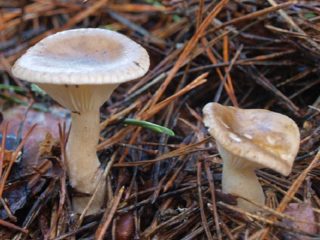Content
Those who have been collecting mushrooms and berries for a long time know how to distinguish edible specimens. The inverted talker is an inedible variety that can attract inexperienced mushroom pickers with its appearance.
Where upside down talkers grow
This mushroom is common in regions with dense coniferous and deciduous forests. It grows in the thicket of the forest, where it is mostly dark and damp.
Inverted talkers can be found throughout Europe, North America, Ireland, and Iceland. Mushrooms can appear at the foot of anthills, on coniferous litter, and on damp, rotting stumps. Inverted talkers grow in close groups: this can be seen in numerous photos of mushroom pickers.
Mushrooms can also cluster 10 to 15 individuals around a selected stump or at the base of a tree. The maturation of inverted talkers is extended. They appear in forests in the summer, remaining elastic and undamaged until autumn frosts.
What do upside-down talkers look like?
Inverted talkers are often called red-brown for the color of the fruiting body. According to their external description, they are similar to some representatives of their own genus, but they also have characteristic differences:
- Their caps can grow up to 14 cm in diameter. In young talkers they have a beautiful orange-brick tint, a matte smooth surface, are convex, but over time they become flat and depressed in the center. The edges of the cap may be wavy with narrow, frequent pale orange plates. Black dots, randomly located, are noticeable on its surface.
- The leg extends up to 10 cm. It is usually dry, thin, slightly pubescent and similar in color to the color of the cap.
You can see the structure of the red-brown talkers in the photo:
When the cap or stem is broken, whitish flesh is revealed. The smell is characterized as sweet, intrusive. After cutting, the flesh remains dense and does not darken.
Red-brown talkers, edible or not
Mycologists classify the inverted talker as an inedible group.But according to some sources, this species contains a toxin and is therefore considered poisonous.
You can learn more about the inverted talker from the video:
How to distinguish upside down talkers
The inverted representative of the family Psatirelaceae is similar to related varieties: funnel-shaped, brown-yellow, waterspotted. Red-brown talkers are difficult to distinguish from related species. Up close, in addition to external description, they use smell for identification. The smell of an inverted talker is reminiscent of a rotting orange, with a hint of bergamot.
- Voronchaty The species is distinguished by the pale coloration on the cap, the absence of a wavy edge, and the absence of black dots on the surface of the cap. This variety has a characteristic mushroom smell.
- Brown-yellow The species is distinguished by the general shade of the fruiting body. The cap and leg become brownish-yellow over time. In young specimens the color is even lighter: it is characterized as creamy yellow.
- Waterspotted The type is distinguished by the white tint of the plates when broken, and fuzzy round spots on the surface of the cap.
Red-brown or inverted talkers grow in entire colonies, while brown-yellow ones prefer to settle on stumps or near tree trunks, 1-2 at a time.
Symptoms of poisoning
Harmful substances that enter the body along with mushrooms can accumulate for 2 - 3 hours before the first signs of poisoning appear.
Poisonous mushrooms cause a reaction within 20 minutes. after reception. This is due to the increased content of poison. However, the inverted talker contains less dangerous toxins: their influence does not give an immediate result.
After taking it, the first symptoms begin to appear, which may not be immediately noticeable:
- slight dizziness;
- slight decrease in blood pressure;
- drowsiness;
- decreased muscle tone.
After a few hours, serious symptoms are added to the mild symptoms:
- nausea with increasing vomiting;
- diarrhea;
- sharp pain in the upper part of the stomach;
- change in skin tone;
- sweating;
- salivation;
- tachycardia;
- pressure surges.
Vomiting and diarrhea can lead to dehydration, which entails accompanying symptoms: severe drowsiness, decreased coordination, fever, general weakness, blurred vision.
First aid for poisoning
An inverted talker can cause severe poisoning due to the content of a complex of toxic substances. If you discover accidental use of this mushroom, you must call an ambulance.
Before the team of specialists arrives, it is first of all important to eliminate the influence of toxins and prevent dehydration after vomiting and diarrhea. To this end, the necessary measures will be:
- drinking fluids to prevent dehydration (preparing a saline solution at the rate of 1 teaspoon per 1 cup of water or using pharmaceutical products: Regidron and analogues);
- the use of enterosorbents to remove harmful substances (Enterosgel, Polysorb suspension solution, activated carbon);
- if the temperature rises, take antipyretics (Paracetomol, Ibuprofen);
- the victim should be in bed, with warm heating pads placed on his legs and stomach.
In some cases, diarrhea and vomiting may be absent, which makes it difficult to diagnose poisoning and entails serious consequences, since toxins do not leave the body. First aid includes artificially inducing vomiting. To do this, drink 1.5 liters of potassium permanganate solution, then press on the root of the tongue.
Conclusion
The inverted talker is an inedible mushroom that is classified as poisonous. Mycologists do not recommend conducting experiments on your own health and trying unknown specimens. If there are doubts about the identity of the found talker, it is better to abandon it and pass by.















